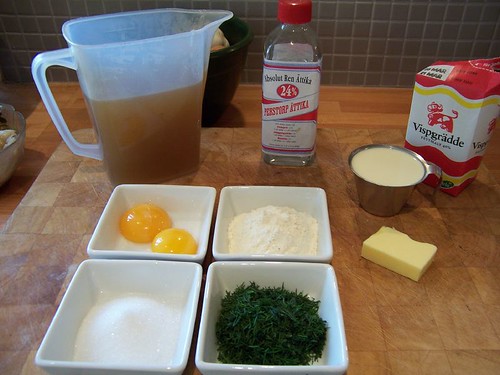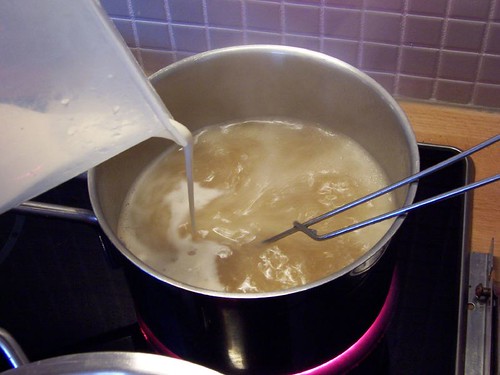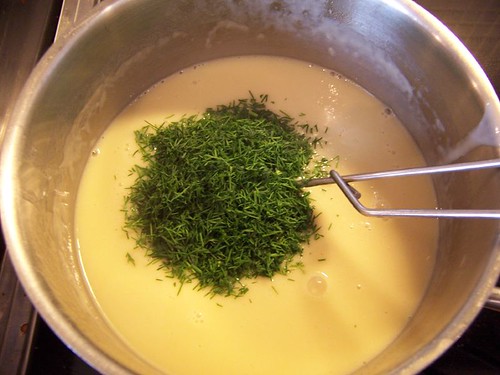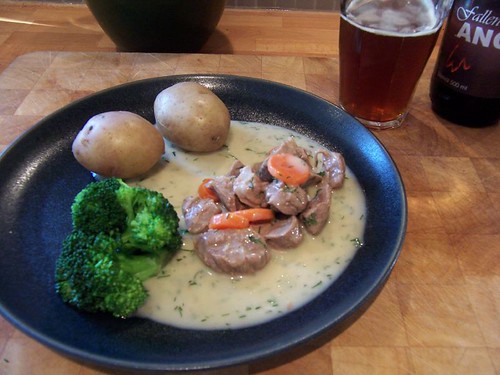More Swedish dinners: "Dillkött"
More Swedish dinners: "Dillkött"
-
-
-
-
-
More Swedish dinners: "Dillkött"
-
Post #1 - March 28th, 2007, 2:21 amWhy is dill so popular in Sweden? It's certainly a flavor that many people associate with Sweden. Gravad lax, Swedish-style crayfish, many types of snaps and preserved herring, even cheese and hardbread - all of these dishes/products use or can use dill as a flavoring.
My only guess is that it's due to dill's adaptability. As a plant, dill is forgiving in terms of temperature (it can survive a cool summar, it can survive a short-lived, Swedish "heat wave"), soil (full of sand or full of clay, dill doesn't mind too much) and even precipitation. As a flavor, dill rarely takes center stage with its clean, crisp flavor but instead compliments and adapts to the main ingredient.
One combination, though, was still foreign to me. Using dill together with red meat. So, I decided to try my hand at a classic, traditional Swedish dish: "Dillkött" (or, literally, "dill meat").

The ingredients for the meat (left to right, top to bottom): about 2 cups veal stock, 2 pounds cubed veal, spices (thyme, bay leaves, ca 10 black pepparcorns and ca 5 whole allspice), one large leek, two small onions, one carrot and a little parsley.
(Dillkött is frequently also made with lamb instead of veal.)
Place all of the meat ingredients in a pot. Bring to a simmer, skim and simmer about 1 hour (or until the meat becomes tender).
After simmering:

I pulled out and discarded the leeks and onions as they are, apparently, poisonous to children under the age of 5*. I saved the carrots and strained the stock.
The next step is to create the sauce.

Sauce ingredients, (left to right, top to bottom): the reserved stock (still about 2 cups), 2 egg yolks, 2 tblsp sugar, 2 tsp destilled vinager (this is 24% but I diluted to 12%), 4 tblsp flour, about 1/2 cup chopped fresh dill, 1/3 cup cream, a few tblsp butter.
Bring the stock to a boil and add the flour (which I made a slurry of by adding a few tblsp water). This strikes me as a very old-fashioned way of thickening a stock and can easily lead to lumps. Next time, I'll probably follow a safer, veloute-type approach and make a roux first to which I'll add the hot stock.

Since I added raw flour to the stock, I was sure to let it simmer and cook for a good 10 minutes before continuing to cook away any raw flour flavor... After 10 minutes I added the cream and the sugar and brought everything back to a boil for a few more minutes.
Remove the boiling, thickened stock from heat and carefully add the vinager. Whisk in the lump of butter and the two egg yolks. Finally, add the dill:

Taste, season (it needed salt and peppar!) and add the cooked veal and carrots.

Dinner almost ready:

Plated:


(I'm toying with a sub-subject for these posts: "Food that looks like cat vomit"...).
With this, I had another of Jämtlands Bryggari's products: Fallen Angel bitter. What can I say? It's a tasty, if not earth-shattering, modernish version of a bitter. It did work quite nicely with the flavors of the dillkött.

How were the flavors? Quite nice, actually and more complex than I normally expect from traditional Swedish cuisine. The amount of sugar involved (2 tblsp) makes its presence quite noticable and, together with the tang of the vinager, creates one of the (if not, THE) cornerstones in Swedish flavors: sweet and sour. The dill plays freshly and nicely on top of this and having a hearty veal stock as a base adds a pleasing fullness and smoothness to the whole thing. I suppose this isn't much more than a Sweden-ized Blaquette de veau so, if you're looking for a twist on this classic dish, give "dillkött" a try.
* This according to my 4.5 year-old son. It's true! Really! My 3-year old daughter confirmed it.Last edited by Bridgestone on March 28th, 2007, 10:56 pm, edited 1 time in total.
-
-
Post #2 - March 28th, 2007, 11:53 amVery nice post - enjoyed the pics. Your cookware is intriguing - particularly the pot handles... Swedish design?
-
-
Post #3 - March 28th, 2007, 12:08 pmThanks Jay K!
Trust me that it pains me to say, no, these are Swedish pots but Danish. The company is EVA and the line is "Eva-trio".
They look decent, are of good, heavy quality and I like the lids - dishwasher safe and see-through.
-
-
Post #4 - October 2nd, 2015, 7:08 amPulling this recipe in to the present! I made this last night (with lamb swapped in for the veal) and it was fantastic! Nuanced, homey, and delicious. Highly recommend giving it a whirl, assuming you like dill

As Bridgestone mentioned, I do recommend creating a roux (with the butter, then flour, then cream) before adding the broth back in. Judging by the picture, the roux created a far firmer, creamier sauce in my version. It coated & clung well to the meat - not runny at all.
Thanks Bridgestone.

